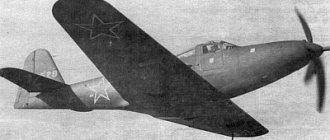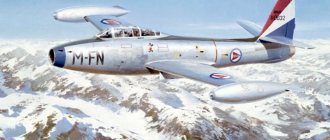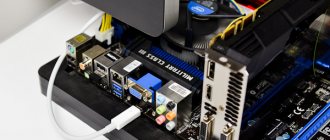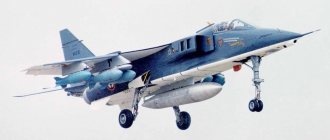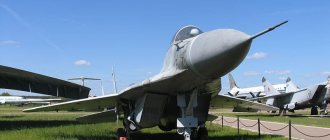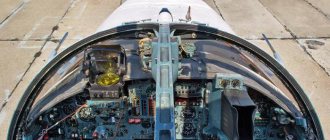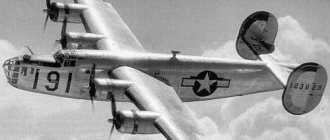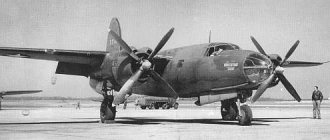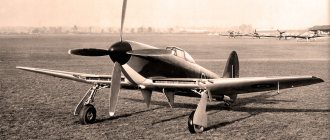The most popular and most famous aircraft of the Second World War, the Curtiss P-40 was developed as an adaptation of the P-36 airframe for the Allison V-1710 liquid-cooled engine. The XP-40 prototype (model 75P) first flew on October 14, 1938.
The aircraft had a V-1710-9 engine and was armed with two synchronized 12.7 mm machine guns. At the beginning of 1939, the aircraft was chosen for further purchases by the US government - although it was inferior in high-altitude characteristics to other fighters with turbochargers, it was inexpensive and could quickly be put into production a year earlier than more advanced models. Subsequently, to produce P-40 aircraft, in addition to the main plant in St. Louis, two more factories were built in Buffalo and Columbus.
The history of the creation of the P-40 "TomaHawk" and "KittyHawk" fighters
The Curtis P-40 Tomahawk fighter was developed by the American company Curtiss. The design basis for this machine was the P-36 Hawk-75 , produced since 1936 and well mastered by industry. In Russian-language literature, it is customary to call the P-40 “Tomahawk” or “Kittyhawk” (I am no exception, for ease of perception), however, this is a factual error - firstly, “Tomahawk” and “Kittyhawk” are not synonyms - these were the names of different modifications of the same and the same plane. Secondly, it is more correct to pronounce both names (“Tomahawk” and “Kittyhawk”) as “Tomahawk” and “Kittyhawk” - as you can see, in this situation the “duality” of the name of the fighter disappears by itself.
However, the pronunciation of the name is not the only “little secret” of this fighter. The answer to another question is much more interesting - why did the United States even undertake to build this rather unique machine, and even with a “circulation” of 14,000 copies, if its characteristics are inferior even to the earlier P-39 “Airacobra” ?
Drawing of the P-40 Tomahawk fighter
The answer lies in the time of its appearance - the war in Europe was already taking threatening turns, and Japan clearly showed that it would not end with the occupation of part of China. In 1939, the US aircraft fleet was almost two times smaller than the Japanese one - the country needed an easy-to-fly (the same Airacobra could not boast of this characteristic) fighter, the production of which could be launched as quickly as possible. The P-40 Tomahawk, in many ways similar to the P-36 Hawk 75 fighter, which , was an ideal candidate.
The fact that the plane completely “didn’t grab the stars from the sky” (don’t think that it was a bad car - just “average”) was not an obstacle - the Tomahawk was needed rather to fill an empty niche, and only subsequently , it had to be replaced by more advanced machines.
ьХПНН ХЯНКЭГНБУБХИЯЪ YANBERYAYHLH bbya B TsNDSH BEKKHYNI nREVEYARBEMMNI BNIMSH YULEPKHYUMYAYKHI KHYARPEAHREKE yEPRKHYA p-40 (PYUGMSHE BYUPKHYUMRSH YNRNPNTsN ANKEE KHGBEYARMSH S M YUYA OND YUMTSKKHIYAYHLH MYUGBYUMHYLH "rNLYUTSYUSY" X "yHRRKHYUSYY") ME GYUYAKSFKHK B YANBERYAYNL YANCHGE YARNKE ANKENI ONOSKPMNYARKH YYU, YAYUFEL, "YUSCHPNYNAPU", OPEYPUYAMNI PEIKYULNI YNRNPNI YARYUKH HYAOYPEMMSHE GBEGDNVYULH BNGDSMSHU ONAED LYUHMSH ONYPSHYHMYU H ETSN YANPURMKHYNB. p-40 NYARYUKYA B REMH YABNHU ANKEE SDYUVKHBSHU YANAPYUREEB. n OPHLEMEMHH ShchRNTSN YAYULNKERYU MYUHLKH YANCHGMKHYULH MYOOKHYYUMN LMNTsN, N DEYARBKHU FE KHU MU YANBERYAYN-TSEPLYUMYAINL TPNMRE - TsNPYUGDN LEMEYE.nDMNLNRNPMSHI ZHEKEMNLERYUKKHVEYAYKHI HYARPEAHREKE p-40 ASHK GYUOSYEM B YAEPKHCH BEYAMNI 1940. nyanaemmn BSHYANYKHLH UYUPYUREPHYARKHYULH NM ME NRKHVYUKYA, MN ASHK OPNYAR, MUDE FEM X REUMNKNTSHVEM B OPNKHGBNDYARBE, VRN X RPEANBUKNYAE ASPMN PYYARSYEI YLEPHYUMYAYNI BNEMMNI YUBHYUZHHH. YaOEMN SIPEOKCHYKHE YABNH bbya yuMTSKH KH tPYUMZHKH RUYFE DUKH MU METSN YABNH GYUYUGSH.
YNTSDU MYUVYUKYUYAE BEKKHYU nREVEYARBEMMYU BNIMYU, SHCHRYU LYUHMYU SFE OPNKYU NOPEDEKEMMSHI OSRE ShBNKCHZHHH. I SVERNL NOSHRYU YUMTSKKHVYUM BBEKH APNMEGEYUHRS (BYKCHVYU APNMEYAREIKN), OPNREIRKHPNBYUMKHE AYUNB, SYAKHKHKH BNNPSFEMKHE, ONYAKEDNBUREKEMN YARYUB MU ONRNY LNDKHTHYUZHKH p- 40b Х p-40я ХУ ШХЯОНПРМШЭ БУПХУМРШ “рНЛУЦУSY I”, “рНLUTSYUSY IIA” Х “рНLYUTSYUSY IIb”. GYUREL I LYU 1941 NYABNHKH OPNKHGBNDYARBN BYUPHYUMRYU I MNBSHL LNRNPNL KH OPYURKHVEYAYH MNBSHL TCHGEKFEL - p-40D, YNRNPNTSN BYAINPE YALEMKHK B ZHEYUU p-40e I EEE ANKEE LNYMSHL BN NPSFEMHEL XG EYARKH YPSOMNYUKHAEPMSHU OSKELERNB (B YUMTSKKHIYAYHU bbya NAE ShchRKH LNDKHTHYUZHHH KHLEMNBYUKKHYAE “yHRRRKHYUSY I”).
oEPBYU OYUPRH YYULNKERNB ASHKYU NRTSPSFEMYU HG yayu BLEYARE I DPSTSHLH BNEMMSHLH LYUREPHYUKYULH DK yayap B YAEMRYAPE 1941. schRN EEE ME ASHKN KEMD-KHGNL, YNRNPSHI MUVYUK PUYAOPNYA RPYUMREYA MU yayap RNKEIN I MNAP - YYULNKERSH ASHKH YSOKEMSH B yuLEPHYE GYU GNKNRN. b ShchRS OYUPRKHCH BUNDHKH 20 p-40 YAYULSHU OEPBSHU YEPHI (AEG BYAYKHU ASYBEMMSHU KHMDEYANB), YNRNPSHE Y SHRNLS BPELEMKH HYAONKEGNBUKKHYAE YLEPHYUMZHYULH RNKEIN DK SVEAMSHU ZH EKEI KH NDHM p-40G — OEPEDEKUMMSHI p-40 I YPSHKNL NR p-40ya (I VERSHPEL DNONKMHREKEMSHLH OSKELERYULH) .
oYUPYUKKEKEMN XG yuMTSKKH I OEPBSHLH YNMBNLH, ED'HLLH B yuPUYUMTSEKEYAY, NROPIUBHKH B BHDE BNEMMNI ONLNYH YABNH "rNLYUTSYUSYH IIb", YUMYUKNTSKHVMSHE p-40ya, MN MEYAINKEIN NR KHVYUBHHEYA OH NANPSDNBYUMHCH X I YPSHKEEBSHLH OSKELERYULH YUMTSKKHIYYINTSN YUKHAPIU 7.A9LL. YuMTSKKHIYAYKHE X YULEPKHIYUMYAYKHE YYULNKERSH MYUVYUKH YANAKHPYURE MU OKNYYUDYE B 25 YL CHFMEE yuPUYUMTSEKEYAYU I ONLNYECH YUMTSKKHIYAYKH REUMKHYNB X YULEPHYUMYAYKHU KERVKHYNB-KHMYARPSY RNPNB, YU GYUREL OEPETSNMJKH B bNKNTsDS. b 1942 “rNLUTSYUSYKH” ONKKH X VEPEG XPYUM. BYAETSN B MUYS YARPIUMS OPHASHKN 146 “rNLYUTSYUSYNB IIb” KH BEKKHYNAPHRYUMHH X EYE 49 B YAVER YUMTSKKHIAYKHU NAYGYUREKEYARB ASHKH NRTSPSFEMSH OPILN I GYUBNDU “YEPRKHYA” B aSTTYUKN.
oEPBSHL, ON-BHDHLNLS, NYABNHK GUNYEYUMYAYSCH REUMHYS 126-I HYARPEAHREKEMSHI ONKY obn. nM OPKHYARSOKHK Y ANEBSHL NOEPYUZHKHL MU "rNLYUTSYUSYUU" 12 NYRUP 1941. deIYARBS MU GYUOYUDMNL X yYUKHMKHMYAYNL TPNMRYUU, ONKY SVIUYARBNBUK B NANPNME lNYAYBSH. gyu LEYAZH ANEB (DN 15 MNAP) KERVHYH ONKYU YANBEPHKH MU YULEPHYUMYAYHU HYARPEAHREKYU 665 ANEBSHU BSHKERNB X YAAHKH 17 YAYULNKERNB BPYUTSIU. YARYUPKHI KEIREMYUMR ya.ts.pKHDMSHI KERYU MU SCHRNI LYUHME ONKSVHK GBYUMKHE TsEPN YANBERYAYNTSN YANCHGYU.
vSRE ONGFE, B MNYAPE 1941, OND KEMKHMTSPYUDNL MU "rNLYUTSYUSYUU" MYUVYUK BNEBURE 154-I ONKY, YU B DEYUAPE - 159-I. NAYU NMH BNKKH B YANYARYUB bNYARNVMNI NOEPYURKHBMNI TSPSOOSH, NAEYAOEVKHBUBIEI OPKHYPSHRHE RPYUMYAONPRMSHU YYULNKERNB, DNYARYUBKBIKHU VEPEG KYUDNTS TsPSGSH B NYYUFDEMMSHI KEMHMTSP YuD. MELJSH NFEYARNVEMMN OSHRYUKHYAE PYUGPSKHRE "BNGDSMSHI LNYAR". b NRPYUFEMKHE XU SDYUPNB BMEYAKH YABNCH KEORS X “rNLUTSYUSYKH”. MUOPHLEP, 17 DAYUAP 1941 o.yu.onYPSHEB HG 154-CN ONKYU (BONYAKEDYARBHH DBYUFDSH CHAINS), GYYYKHYU RPYUMYAONPRMSHE LYUKHMSH I ORRECH "YEPRKHYYULH" OPKHMЪK ANI OPNR KhB DEBERKH "LEYAYEPLHRRNB". ELS FE NDMNLS HG OEPBSHU MU YANBERYAYN-TSEPLYUMYAINL TPNMRE SDYUKNYAE YAKHRE LNDEPMKHGHPNBYUMMSHI HYARPEAHREKE "LEYAYAEPLHRR bf-109f". yu YNLSHCHYAYS o.yu.oHKCHRNBS B NDHMNVYS OPKHKNYAE YANOPNBNFDYURE DEBRYS oya-84. oPHYPSHBYU KH B ONEDKHMYE I EYARECH MELZHYULH NM YAAKHK DBSU H ASHK ONDAHR YAYUL.
MEYAINKEIN LYUHM SCHRNTSN RHOYU KHLEK KHGBEYARMSHI 2nd TSBUPDEYAYKHI YALEYUMMSHI YUBKHYUONKY bbya yaEBEPMNTSN TKNRYU.
MUYUH KERVKHYKH NZHEMKHBYUKH “rNLYUTSYUSY” B ZHEKNL BSHYE, VEL YUMTSKKHIYAYKHI “UYUPPHYEIM”, YNRNPSHI DEYARBKHREKEMN SYARSOYUK YULEPKHYUMYAYNI LYUKHME HE BYAEL NYAMNBMSHL ONYUGYUREKIL, YPNLE BGKERMN-ONYUDNVMSHU UYUPYUREPHYARKHY. NDMUYN, BYAE ASHKH YANTSKYUYAMSH I REL, VRN SHCHRYU LYUHMYU LMNTSN USFE KH YANBPELEMMSH YANBERYAYKHU KH MELEZHYKHU KHYARPEAHREKEY. MEDNYARYURNVMYU YAYNPNYARE X OKNUYU YAYNPNONDZELMNYARE PAINLEMDNBYUKH ITS ME KSVIHL NAPUGNL. nRLEVYUKHYAE X ONKNFHREKEMSHE YUVEYARBU - SDNAMYU YUAHMYU I UNPNHHL NAGNPNL, TNMYUPE UNPNYEI OPNGPYUVMNYARKH I SYARPNIYARBNL YUBYUPKHIMNTSN YAAPNYU, MEOKNUNE BNNPSFEMKHE - YAYE SMDMSHI GYUKO "rNLYUTSYUSYU IIB" ONVRH BDBNE OPEBSHJUK RUYNBNI FE S lHts-3. LYUMEBPEMMNYARE MU TsNPKHGNMRYUKU ASHKYU USFE, Led S BYAU YANBERYAYKHU KH MELEZHYKHU HYARPEAHREKEY, MN KSVIE, Led S “uYUPPKHYEIMYU”
nyanaemmn BSHDEKKYUYAE GMYUVHREKEMYU ON YANBERYAYHL LEPIYUL DUKEMNYARE ONKERYU - DN 1100YL. lNRNP "YUKKKHYANM" OPH PUANRE MU ONMHFEMMSHU NANPNRYUU H AEDMNI YALEYAH NRKHVYUKYA UNPNNEI SHYNMNLHVMNYARECH H YAYULNKER LNTs DNKTSN DEPFYUREYA B BNGDSUE. schRN ONGBNKKKN SHTTEIRKHBMN HYAONKEGNBURE "rNLYUTSYUSY" YUY KHYARPEAHREKE YANOPNBNFDEMHЪ KH DK ONKERNB MYUD LNPEL.
oNKNFHREKEMN NZHEMHBUKYUYAE RUYFE OPNVMNYARE X MUDEFMNYARE OKYUMEPY YYULNKERYU X UNPNNYU GYUHRYU KERVKHYU - APNMEYAREIKN MU MUYHU KHYARPEAHREKU RNTSDU ONVRKH ME OPHLEM KNEA.
MELYUKNBUFMN ASHKN H RN, VRN YAYULNKER ASHK BONKME DNYARSOYEM KERVHYS YAPEDMEI YBYUKHTHYUZHHH, SARNIVHB H "OPEDSOPEDHREKEM" B ONKERE. xGBEYAREM YAKSVYUI, YNTsDU B 1942 OPHELYKHY LUINP m.h.uPYULNB Yu yuPUYUMTSEKEYAYE GYU MEYAINKEIN VYYANB NGMYUNLHKYA I "rNLUTSYUSYNL" KH BGKEREK MU MEL, BSHONKMHB YNLOKEY I THTSSP BSHYAETSN OHKNRYUFYU.
gYYAKSFEMMN BSHYANYN NZHEMHBUKYUYAE OPNVMNYARE KH FHBSVEYARE LYUHM. YaBKHDEREKEYARBNL SHRNLS LMNTsNVHYAKEMMSHE SDYUVMSHE RYUPYUMSH, YANBEPEMEMSHE YANBERYAYHLH KERVHYYULH MU “rNLYUTSYUSYUU” X “yHRRKHYUYUYUU”. oEPBSHL, ON-BKhDHLNLS, ASHK YUOKHRYUM yu.a.vKHPYNB HG 154-TsN ONKYU: 20 ЪМБУПЪ 1942 NM RYUPYUMHK "RNLYUTSYUSYNL" MELEZHYKHI YAYULNKER B PUINME ONTSNYARE. yu CHENNI YANBERYAYNTSN YANCHGYU yu.ya.ukNASHYARNB HG 147-TSN RYUPYUMHK RPHFDSH, OPHVEL OEPBSHE DBYU PYUGYU - B NDMNL X RNL FE ANCH. ANKEE RNCN, X AKHK NM NDMNI X RNI FE OPYUBNI OKNYAYNYARECH. ІЯРЭПІУ MUJHU KHYARPEAHREKEY BYARPERHKYUYAE I ANKENI TSPSOONI “chMYEPYANB” X “LEYAYAEPLHRRNB”, EDYEI MY lSPLYUMYAY. KHYARPYURKHB B ANCH ANEOKHOYUYASH, UKNASHYARNB SDYUPNL YAGYUDKH PUGAKHK UBNYARNBNE NOEPEMKHE NDMNTSN KH MELEZHYKHU HYARPEAHREKEY. oPNDNKFYU SOPYUBKRE LYUKHMNI, NM BRNPNI PYUG ONYEK MU RYUPYUM - REOEPE SFE KNANBNI - X YAKNLYUK YPSHKN "LEYAYAEPLHRRS". nRYUGYUBHYAE BSHOPSHTSMSRE I OYUPYUCHRNL, TSEPNI AKYUTSNONKSVMN DNRJMSK DN PNDMNTSN YUSCHPNDPNL. ShRN YAKSVHKNYAE 8 YUOPEK 1942. b ShRNL FE ANCH EYE NDHM RYUPYUM YANBEPHK YUOHRYUM yu.oNGDMYINB. yu B LYUPRE 1943 DBYU "yHRRKHYUSYU" XG 766-TSN ONKYU BYARSOKHKH B ANI I DBEMUJYURECH "LEYAYAEPLHRRYULH". kEIREMYUMR a.mHYNKYUB OPNRYUPYUMHK MELJU X YAOYUYAYAJ MU OYUPYUCHRE.
I REUMKHVEYAYNI SCHYAOKSYURYUZHHEI "RNLYUTSYUSYNB" B YANBERYAYNL YANCHGE ASHKN MELYUKN UKNONR. kNLYUKHYAE LEYAREPMKH X UBNYARNBKHYKH SHKEIRPNTSEMEPYURNPNB X HU GYULEMKKH MU NREVEYARBEMMSHE Tsya-650. nRYUGSHBYUKH LNRNPSH "YUKKKHYANM" - OKYUBKHKHYAE KH GUYKKHMKHBYUKH ONDKHOMKHYKH (OPEDONKYUTSYUCHR, VRN HLEMMN SCHRN ASHKN OPHVKHMNI TSHAYEKH KHGBEYARMNTSN YAEBEPNLNPAYNTSN YUYU a.YUT NMNBYU), OEPETSPEBYUKNYAE LYUYAKN. xG-GYU DETEIRNB LYUYAKNYAHYARELSH MU ANPRS YAKSVYUKHYAE ONFYUPSH - RYUY, MYOOPHLEP, TSNPEC TSPEN YANBERYAYNTSN YANCHGYU k.uYUPHRNMNB B 964-L ONKYS. b VYUYARU LYUYAKNYAHYARELS VYUYARN DNPUAYURSHBUKH. "YUKKKHYANMSH" MEPEDYN "YARPEKKKH YURSMYULKH" VRN OPKHBNDHKN Y RFEKSHL YUBYUPKHL. ONMYUVYUKS ME UBURYUKN ANEOPHOYUYANB: OEPBSHE ONKSVEMMSHE HG-GYU PSAEFYU LYUHMSH YNLOKEIRNBYUKKHYAE KHLH BYAETSN MU VERSHPE - ORE BSHKERNB. rPSDMN ASHKN X I GYUOYUMSHLH VYUYARLH - HU, B NYAMNBMNL, YAMHLYUKH I PUGAHRSHU YYULNKERNB.
NYANAEMMN RFEFKN OPHUNDHKNYAE "rNLYUTSYUSYUL" GHLNI - NMH NYUGYUKHYAE YANBEPYEMMN MEOPKHYAONYANAKEMMSHLH Y GHLMEI SHYAOXYURYUZHHH. nR UNKNDYU PYUGPSHBUKN YANRSH LYUYAKNPYUDHYURNPNB, KNOYUKHYAE YYULEPSH YNKEYA. gYUTSSYAREBUKYU H GYULEPGYUKYU YALEYAE “kNYUHD #5” B TsKHDPNYAHYARELE, HG-GYU VETSN NRYUGSHBUKN YUYAYAH. aNPNKHYAE I SCHRHL ON PYUGMNLS. LYuYAKN X TsKhDPNYALEYAE MU MNVE YARYUKH YAKHBURE, RUYFE YUY X YUMRKHTPKHG KH YAKHYARELSH NUKYUFDEMH, BPEGYUB DK SCHRNTSN B LYUTSKHYARPYUKH YAKHBMSHE YPYUMSH. gYULEMKKH KHLONPRMSHE YALEYAH NREVEYARBEMMSHHLH, YNRNPSHE KSVIE OPEMNYAHKKH LNPNGSH. yu LEUUMHYUL 154-CN ONKYU DK OYUIYH PUGNPBUMMSHU PUDHYURNPNB OPKHKNYAE DUFE YANAHPURE ON YAEKYUL YAEPEAPMSHE KNFYH.
ONYAINKEYS "rNLYUTSYUSY" OKNUN ONDUNDHK DK PUBMNTSN AN YA KHYARPEAHREKLH OPNRKHBMKHYU, ETSN S MUYA YARYUPYUKHYAE OPHLEMRE YUY KHYARPEAHREKE obn KH DK SDYUPNB ON M YUGELMSHL ZHEKIL. dK SYAKHKEMKH NTSMEBNI LNYH "RNLYUTSYUSYKH" NANPSDNBYUKHYAE MUOPYUBKCHYHLH OND VERSHPE PUYERMSHU YAMYUPDYU pya-82, YNRNPSHE HYAONKEGNBUKHYAE DK ONPUFEHMKH BPYUFEYAYKHU AN LAYUPDHPNBYKHYNB X YUBRNAPNMERYUMYNBNI REUMKHYKH BPYUTSIU.
I MYUVYUKYU 1942 OYUPYUKKEKEMN I “rNLYUTSYUSYULH” B yayap MYUVYUK ONYARSOYURE KH SYANBEPEMYARBNBUMMSHY BYUPHYUMR - “yHRRKHYUSY I” (p-40e). ONYAINKEYS MU GYUOYUDE p-40 HYAONKEGNBUKYA B OEPBSCH NVEPEDE YUY LRSPLNBKHY, RN X YANBEPYEMYARBNBYUMKHE LYUKHMSH YKN HLEMMN B ShchRNL MUOPYUBKEMXX: SYAHKHKH APNMEGUYHRS . MN BYAE SHRN ONDMЪKN BEYA KHYARPEAHREK KH GUYNMNLEPMN SUSDDHKN YAYNPNONDZELMNYARE, YAMKHGHKN ONRNNKNY, SBEKHVHKN BPEL BSHONKMEMHЪ BHPYUFEI, DKHMS PYUGAETSIU MU BGKERE KH N YANAEMMN OPNAETSU OPH ONYUYUDYE.
oPNDNKFYUBKHE OPHASHBURE "RNLYUTSYUSYKH" OEPEDYUBYUKHYAE MU ONONKMEMKHE VYUYARL, SFE KHLEBHL SHCHRKH LYUKHMSH, YU RUYFE ONYARSOYUKH MU BNNPSFEMKHE VYUYAREI obn. RYUY BEYAMNI 1942 KHU ONKSVHK 964-I ONKY obn, PYYAONKYUTSYUBKHIYA BNYARNVMEE KEMKHMTSPYUDYU. b ShchRNL ONKYS XG NDMNTSN “rNLYUTSYUSYU” YADEKYUKH SVEAMSC YAOYUPYS I NVEME REYAMNI BRNPNI YUAKHMNI. b YAHYARELE obn "rNLYUTSYUSYKH" SDEPFYUKHYAE DN YNMZHJU BNIMSH: DUFE B 1945 RYUL EYE HLEKNYAE 27 RYUHU YYULNKERNB.
oEPBSHHLH S MUYA ONKSVIUKH “yHRRHYUSYYH” RE FE ONKYH, YNRNPSHE SYAOEMN NYABNHKH “rNLYUTSYUSY”. b NYAMNBMNL ONYARSOYUKH LNDKHTHYUZHKH "yHRRKHYUSY I" X "yHRRKHYUSY Iyu", BSHOSYYUBKHEYA MU SHYYAONPR B yuMCKKHCH, B RNL VHYAKE X RPNOHVEYAYHE BYUPKHYUMRSH I LNYMSHLH "OSYARSHMMSHLH » THKERPYULH. b ANKEHMYARBE YAKSVYUEB B yayaap ShchRKH THKERPSH YAMKHLYUKH (MYUOPHLEP B 154-L ONKYS), RYU YUY NMH SBEKHVKHBYUKH YUSCHPNDKHMYULHVEYAYNE YANOPNRKHBKEMKHE, MN YNE-TsDE NMH SIAOEMN OPHLE MYKKHYAE, B VYUYARMNYARKH, MU OYAVYUMSHU YUSCHPNDPNLYU gYUONKЪPE.
"YHRRKHYUYUSYNB" ьКН ГМУВХРЭКЭМН АНКАЕ, VEL "рНЛУЦУСНБ", Х MU MХУ YARYUKH OPEBNNPSFYURE BYAE MNBSHE VYUYARKH. BEYAMNI 42-CN ShchRKH HYARPEAHREKH ONYARSOKHKH B MEINRNPSHE SHYAYUDPHKEH ONKYNB 258-I YALEYUMMNI YUBKHYUDKHBKHGHKH MU yUPEKEYAYNL TPNMRE. oEPBNI RULE NYABNHKYU SHRKH LYUKHMSH 2-Ъ SHYAYYUDPHKEЪ 19-TSN TSBUPDEYYNTSN ONKYU. oPHLEPMN B SHRN FE BPEL ONKSVHKH "yHRRKHYUSYKH" B YALEYAKH I "uYUPPHYEIMYULH" ONKYKH 122-I DKHBKHKH obn, OPKHYPSHBYUBYEI lSPLYUMYAY. MU YAEBEPN-gYUOYUDMNL TPNMRE MU SHCHRKHU KHYARPEAHREKU YARYUKH KERYURE OKHKNRSH 436-TsN ONKYU rev. ONYARSOYUKH NMH KH B LNPYAYSCH YUBHYUZHKHCH, MUOPHLEP, B GMYULEMHRSHI 2nd TsBYUPDEIAYKHI YALEYUMMSHI ONKY MU yaEBEPMNL TKNRE KH B 7-I HYARPEAHREKEMSHI ONKY MU VEPMNL LNPE.
with MUYA YARYUPYUKHYAE B OEPBSCH NVEPEDE HYAONKEGNBURE OKCHYASH SCHRNTSN YAYULNKERYU - LNYMNE BNNPSFEMKHE (UNRЪ ON YAYSMDMMNLS GYUKOS p-40e MEYAYNKEIN SYARSOYUK MELEZHYNLS FW190yu-3 X YUM TSKKHIYAINLS "YAOKHRTUIPS Vya", MN REL ME LEMEE OPEBNYAUNDHK X "LEYAYAEPLHRR Bf-109f", X YULEPKHYUMYAYKHI p -39D), ANKESCH DUKEMNYARE KH OPNDNKFHREKEMNYARE ONKERYU, FHBSVEYARE, UNPNEE ON YANBERYAYHL LEPIYUL RNTSN BPELEMKH PUDHN-H OPHANPMNE NANPSDNBYUMKHE. ONSCHRNLS "YHRRKHYUSYKH" OPHLEMKKH RULE, TsDE ShchRKH YUVEYARBU LNFMN ASHKN PEYUKKHGNBURE - B obn, DK ANLANBSHU X RSPLNBSHU SDYUPNB, DK YANOPNBNFDEMKH X PYUGBEDYKH.
bN BRNPNI ONKNBKHME BNIMSH ANKEYU VYUARE "YHRRKHYUSINB" ASHKYU MUOPYUBKEMYU B YAKHYARELS obn. rYUL NMH I 1942 ASHKKH YYULSHL LYUYAYANBSHL ONYAKE “uYUPPHYEIMYU” KHMNYARPUMMSHL HYARPEAHREKEL, YU B 1945 NOPEEDHKH KH “uYUPPHYEIM”, KH “yaOKHRTUIP IX” BLEYARE BG'RSHE. LYUKNOPHTSNDMSHI DK AN I BPYUFEYAYHLH KHYARPEAHREKLH "YHHRRKHYUSY", GY YAVER YAYNPNYARH KH LNYNTSN BNNPSFEMKH LNTS SHTTTEIRKHBMN ANPNREYA I ANLAYUPKHPPNBYYULH OPNRKHBMKHY Yu. bSHYE 4500L p-40e NATSNMJK YY-1, UNR LNRNP "YUKKKHYANM" MU GYUOYUDE YAVKHRYUKYA MHGYINBSHYANRMSHL. ANKEYU OPNDNKFHREKEMNYARE ONKERYU MU YPEIYEPYAYNL PEFHLE ONGBNKKYU AYUPPUFHPNBURE MYUD NUPYUMYELNL NAZEIRNL HKH PUINMNL.
“YHRRRKHYUSY” HLEK DBYU NYAMNBMSHU MEDNYARYURYU YUY OEPEUBYURVKHY - MEANKENNI ONRNNKNY X OKNUSCH YAYNPNONDZELMNYARE. UNRЪ NM HYAONKEGNBYUKYA KH MNVECH (MYUOPHLEP B 154-L ONKYS), NRYASRYARBHE YUYUKHU-KHAN SYARPNYARB NAMYUPSFEMKH ZHEKEY B RELMNRE ME ONGBNKKKN MH BEYARKH YYULNYARNREKEMSHI OPEUBYUR OPH NRYASRYARBKH BKHDHLNYARKH, MH BSHONKMRE YNLYUMDSH MYUBEDEMKH ON DUMMSHL MYUGELMNI pkya HG-GY RPSDMNYAREI I NPKHEMRKHPNBYUMHEL. DUFE TYUPS MU "YHRRKHYUSYE" MEKEG ASHKN HYAONKEGNBURE B ONKERE - NMU ASHKYU BSHDBHFMNI KH BSHOSYAYURE EE PUGPEYUKNYAE KKHE MU YAYNPNYARKH, AKHGYNI Y ONYUDNVMNI. schRN VERYN OPNЪBHKNYAE OPH NRPYUFEMKHH MYUKERYU MELZHEB MU YULEPHYUMYAYSCH YUBHYUAYUGS B lHPTsNPNDE B KHCHME 1944, YNTsDU ONDMIRSHE B BNGDSU KHYARPEAHREKH 310-I YUBHYUDHBHGH X obn RELMNI AEGKSMMNI MNVECH ME YALNTSKKH NAMYUPSFKHRE MH NDMNTsN YYULNKERYU MELEZHINTSN YANEDHMEMKH.
b obn “YHRRKHYUSYKH” OPHLEMKYA RUYFE B PNKH YAYULNKERYU - NYABERKHREK. RYUHE LYUKHMSH GYUMKHLUKH ONGHZHCHCH MU 2500-3000 L BSHYE YARPN BPYUFEYAYKHU MNVMSHU ANLAYUPKHPPNBYKHYNBH YAAPYYASHBYUKH BMHG YABERYKHEYYUBHYUANLASH YAYUA-100, ONDYABEVKH BYU ZHEKH DK YURYUSCHYKHU. b SCHRNL YUVEYARBE “yHRRKHYUSY”, ONDMKHLUBKHI EYARE yaYuA-100, ASHK KSVIE, VEL “uYUPPHYEIM” (VERSHPE) X NREVEYARBEMMSHE HYARPEAHREKH (ON DBE). b RUYNL YUVEYARBE YYULNKER ASHK BOEPBSHE SYAOEMN OPHLEMEM OND YHEBNL B 1944.
nVEME VYUYARN “yHRRKHYUSYKH” HYAONKEGNBUKHYAE YUY ha. bNGLNFMNYARE OPHLEMEMKH SHCHRKHU LYUKHM DK ANLANLERYUMKH ASHKYU NYNAEMMN ZHEMMYU B 1942, YNTSDU B YABGKH I MEUBURYNI MU TPNMRE ANLAYUPDHPNBNVMNI YUBKHYUZHKH ASHK KHGDYUM I OEZHHYUKEMSHI OPHYUG MYUPYNLYU NANPNMSH "n OPHLEMEMHH KHYARPEAHREKEMNI YUBHYUZHHH MU ONKE AN B YUVEYARBE DMEBMSHU ANLAYUPKHPNBIKHYNB." b 154-L ONKYS NASHVMN BEYUKH NDMS ANLAS tyua-250 OND TCHGEKFEL - SCHRNR BYUPKHYUMR DKЪ p-40e YAVKHRYUKYA RYURMSHL, Yu B 78-L ONKYS MU YaEBEPMNL TKNRE APIUKH X tua-500 . VYUYARN HYAONKEGNBUKH YNLAKHMYUZHCH HG NDMNI tyua-250 X DBSU ANLA ON 100 YTS. MUOPHLEP, BN BPEL SDYUPYU YAEBEPNLNPYAYKHU KERVKHYNB ON ONPRS yHPYEMEYA “YHRRKHYUSYKH” MEYAKH ON NDMNI TSSYUYAMNI tyua-250 X DBE GUFKHTSYUREKEMSHU gya-100. MU YAEBPE ZHEKLKH DK "YHRRKHYUSINB" ASHKKH ME RNKEIN YUSCHPNDPNLSH, RPYUMYAONPRMSHE YAPEDYARBU, SIPEOKEMKH, MN X YNPYUAKH OPNRKHBMKHYU. SFE SONLKHMYUBKHIYA 76-I ONKY HYAONKEGNBYUK KHU DK RNOLYUVRNBNTSN ANLANLERYUMKH. oPH SCHRNL ANLAYU YAAPYYASHBUKYUYAE I TsNPKHGNMRYUKEMNTSN ONKERYU MYUD YAYULNI BNDNI H PKHYNYERKHPPNBUKYU NR ITS ONBEPUMNYARKH, ONYU ME ONPUFYUKYU ANPR YNPYUAK. RYUYKHL YAONYANANL TsPSOOYU YYULNKERNB, BEDNLYU YUOHRYUMNL b.o.YARPEKEMKHYNBSHL, GYU NDHM DEME 11NYRJAP 1944 ONRNOHKYU DBE AYUPFKH LEYARE LNRNANRNB.
NTSMEBSCH LNYE "YHRRKHYUSYU" RUYFE MYUPYYHBUKH ONDBEYAYNI PEYURKHBMSHU YAMYUP'DNB - OH DBU pya-82 OND YUFDSHL YPSHKNL. xU OPHLEMKKH YUY ON YAYULNKERYUL OPNRKHBMKHYU, RYU H ON MUGELMSHL ZHEKL.
bN LMNTSKHU LEYARYUU S MUYA “yHRRKHYUSYKH” HYAONKEGNBUKH DK PUGBEDYKH - KH BKHGSYUKEMNI, KH TNRNTSPUYUTKHVEYAYNI. dKЪ TNRNPYUGBEDYKH NASHVMN SYARYUMYUBKHBYUKH B UBNYARNBNI VYUYARKH LYUKHMSH NDHM OKYUMNSHI TNRNYUOOYUPYUR. RYUY, B 30-L PUGBEDSHBUREKEMNL ONKYS bbya VEPMNLNPAYNTSN TKNRYU MU SHCHRKHU LYUHMYU KERYUKYU 3-Ъ SHCHAYYUDPHKEH h.m.mNBKHYNBYU. hLEKHYAE ONDNAMSH OEPEDEKYKH B 118-L PUGBEDSHBUREKEMNL ONKYS MU yaEBEPMNL TKNRE KH B DPSTSKHU LEYARUU. BYAE ShchRKH DNPYUANRYKH BSHONKMKKHYAE OPILN B VYUYARU X YASYYYARBEMMN PYUGKHVYUKKHYAE LEFDS YANANI. MU KEMKHMTSPYUDYYNL TPNMRE ASHK KHCTSNRNBKEM YAOEZHYUKEMSHI DBSULEYARMSHI PUGBEDVKHY OND LYUPYNI p-40et (UNR GYU NYAMNBS ASHK BGUR, BKHDHLN, ME p-40e, YU MEYAINKEIN NRKHVYU CHYKHIYA NR METSN p-40y-5). bNNPSFEMHYU ME ASHKN BNNAYE, YU YANNRBERYARBSCHYKHE NRYAYEKH YPSHKYU ASHKH GYUMRSH DNONKMHREKEMSHLH AEMGNAYUYULH. b yyu X yuMTSKKHH p-40 YUY PUGBEDVKHY OPYURKHVEYAYKH ME HYAONKEGNBUKYAKH YAOEZHHYUKEMSHE PUGBEDSHBUREKEMSHE BYUPKHYUMRSH ETSN ME YARPNHKHYAE - EDKHMYARBEMMSHI up-40yu RYU X NYAR YUKYA NOSHRMSHL NAPYUGZHNL.
BEYAMNI 1942 VYUYARKH, YAPYUYUYCHYKHEYA OND KEMKHMTsPYUDNL, HYAOSHRSHBYUKH NYARPSCH MEUBURYS GYUOYUYAMSHU LNRNPNB "YUKKKHYANM". xG-GYU SHRNTSN ANKENNE VHYAKN “rNLYUTSYUSYNB” X “yHRRKHYUSYNB”, LNRNPSH YNRNPSHU BSHPUANRYUKH PEYASPA, NYUGYUKNYAE MU OPHYNKE. b 154-L ONKYS B LYUE 1942 AEG LNRNPNB YARNKKH ONVRKH BYA LYUKHMSH. schRN ASHKN REL ANKEE MEREPOHLN, VRN KHYARPEAHREKEY B RNR OEPHND KH RYU NYARPN ME UBURYUKN. mu 1-I YUBKHUPELAYUGE 13 by B kEMKHMTSPYUDE ON KHMKHZHYURKHBE YNLYUMDHPYU 154-TSN ONKYU yu.yu.lYURBEEBYU H ONKYINBMKHYU o.lyukKHYNBU GYUMKKHYAE OPEDEKYNI p-40 OND YANBERYA YHE LNRNPSH l-105o X l-105p. BYAETSN RUYHL NAPUGNL ASHKN OEPEDEKUMN ANKEE 40 HYARPEAHREKEY, B RNL VHYAKE H MEYAINKEIN DBSULEYARMSHU RPEMKHPPNBNVMSHU LYUHM. ryuyuyu BSHMSFDEMMYU OEPEDEKYU SUSDHKYU UYUPYUREPHYARHYH p-40. LYUYAKHLYUKEMYU YAYNPNYARE S GELKH I LNRNPNL l-105o X BKHMRNL bkh-61o SOYUKYU I 477 DN 465 YL/VYUYA. ANKEYU VUYARE OEPEDEKYUMMSHU RYUHL NAPUGNL YYULNKERNB ASHKYU YANAPEDNRVEMU B 196-L ONKYS, DEIYARBNBUYHL MYUD KYUDNCNI. b ЪМБУПЭ 1943 VERSHPE "рNLUTSYUSYU" I l-105 (B RNL VHYAKE NDMYU YAYULNDEKEMYU YAOYUPYU I NRYPSHRSHLH YUAKHMYULKH LNRNPNL l-105p) KhG 156-RN ONKYU ASHKH OPHDUMSH 12-AND NRDEKEMNI YNPPEIRKHPPNBNVMNI SHYAYUDPHKEE. nMH KERYUKH RULE DN DAYUAP, OPKHYPSHBUYU PUGBEDVHYKH YAS-2 X YEPRKHYA n-52 OPH DMEBMSHU BSHKERYUU.
mu "rNLYUTSYUSYUU" X "yHRRKHYUYUYUU" SYAOEMN YAPYUFYUKHYAE I BPYUTSNL. MUOPHLEP, LYUINP MUIDEMNB MU "rNLYUTSYUSYE" X "YHRRKHYUSYE" DN LYU 1942 YAAHK 16 MELEZHYKHU YYULNKERNB X YARYUK TZEPNEL YANBERYAYNTSN YANCHGYU. nM ASHK DUKAYN ME EDHMYARBEMMSHL. dBYUFDSH TZEPNEL YARYUK o.yu.ONYPSHEB HG 154-TSN ONKYU, B YNRNPNL ASHKH KH DPSTSKHE KERVKHYKH, SDNYARNEMMSHE SHRNTSN BSHYANINTSN GBYUMKH, BYKCHVYU SFE SONLKHMYUBYUBYETSNYA Yu.b.vKHPYNBU. ZEPNEL YANBERYAYNTSN YANCHGYU YARYUK B LYUPRE 1945 X YYUOHRYUM b.ts.YARPEKEMKHYNB - LYUYAREP RNOLYUVRNBSHU SDYUPNB. schRNR YAOHYANI LNFMN OPNDNKFYURE DNACN. oPHLEVYUREKEMN, VRN HG KERVKHYNB YANCHGMKHYNB, BNEBYUBKHU MU SHRNL KHYARPEAHREKE, MKHYRN DUFE AKHGYN ME ONDNYEK Y YNKKHVEYARBS ONAED, NDEPFYUMMSHU, MYOOPHLEP, UKNASHYARNBSHL . b ЪМБУПЭ 1943 MU YaEBEPN-gYuOYUDMNL TPNMRE JEPFYUMR yu.aNPNDYUVEB MYuOPYUBHK YABNI TsNPYYKHI “yHRRKHYUSYY” B MELEZHYKHI DPR.
YANBERYAYKHI YANCHG ONKSVIUK "YHRRKHYUSYKH" ME RNKEIN LNDHTHYUZHHH n-40e, MN H ANKEE ONGDMHE n-40F, n-40y, n-40M, YU GYUREL H ONYAKEDMCHCH YAEPHIMSCH LNDHTHYUZHHH n-40N. schRKH LYUKHMSH ONYARSOYUKH B NYAMNBMNL B ONKYKH obn KH B LNPYAYSCH YUBKHYUZHCH, VRN ONGBNKKHKN BNGLEYARKHRE ONREPH LYUKHM ANKEE PYUMMKHU BYUPKHYUMRNB Yu 1942-43. b 1942 VYuYARKH obn ONREPKKH ANKEE ONKNBKHMSH ONKSVEMSHU "yHRRKHYUYUSINB", B 1943 OPHLEPMN NDMS EYARCH. b VYUYARMNYARKH, p-40N B 1943 ONKSVHK 147-I TsBYUPDEIYAYKHI ONKY rev.
bNNAYE S MUYA BYAE p-40 ONYAKE p-40e NANGMYUVYUKHYAE B DNISLEMRYUU OPNYARN YUY "YHRRKHYUSYY" AEG SYUGYUMH LNDKHTHYUZHHH (EYAKKH ME YAVKHRYURE NRVERNB RYUKHU NPTSYUMKHYUZHHI, YYUY mhh bbya). schRN YASYYYARBEMMN GYURPSDMYER BNGLNFMNYARE SYUGYUMKH LEYAR OPHLEMEMH NRDEKEMSHU LNDKHTHYUZHHI. kKHYE OH TNRNTsPYUTHL LNFMN NOPEDEKHRE LNDKHTHYUZHCH X YAEPKHCH LYUKHMSH, DU X RN ME BYAETSDU.
b YANBERYAYNL YANCHGE “yHRRHYUSYKH” DNFHKH DN YNMZHYU BNIMSH. b 1945 MUYU OPNRKHBNBNGDSMYU NANPNMYU EYY PUYAONKYUTSYUKYU 644 “iHRRKHYUYULH” - SHRN ASHKN ANKEYE VELED KCHASH DPSTSKHU KHMNYARPUMMSHU KHYARPEAHREKEY. b ONYAKEBNEMMNE BPEL BYA NMH ASHKKH OSYEMSH MU YAKNL. b MUYARNYEE BPEL EDHMYARBEMMSHL NRPEYARYUBPHPNBYUMMSHL SHYGELOKPNL “YHRRRKHYUSYU” S MUYA B YARPIUME PUYAONKYUTSUER LSGEY bbya yaEBEPMNTSN TKNRYU. yPNLE RNCN, MU yaEBEPE MUIDEM X DNYARYUBKEM B LNYAYBS “RNLYUTSYUSY”. yu BEDE HU MYYAVHRSHBYUKNYAE B MUYEI YUBKHYUZHHH 2200 рSY.
sTSNKNY MEAYU. 2004
Design and modifications of the P-40 "TomaHawk" and "KittyHawk" fighters
The P-40 Tomahawk fighter was an all-metal fighter with a monocoque fuselage and a low-mounted cantilever wing with aluminum alloy skin. The rudder and ailerons were covered with canvas. The wing is multi-spar, one-piece.
Gas tanks were located in the central part of the wing. Another tank was located in the fuselage behind the cockpit. Fuel pumps and lines were concentrated in a long, narrow ventral fairing. The Tomahawk's gas tanks were not protected, and the pilot also did not have any armor protection.
Characteristics of P-40
A country:USAType:FighterYear of issue:1939Crew:1 personEngine:V-12 Allison V-1710-39, 1150 hpMaximum speed:580 km/hPractical ceiling:8800 mRange of flight:1100 kmEmpty weight:2880 kgMaximum take-off weight:4000 kgWingspan:11.38 mLength:9.66 mHeight:3.76 mWing area:21.92 sq.m.Weapons:6× 12.7 mm machine guns (281 rounds per barrel)
Main modifications of the P-40 fighter:
- P-40 TomaHawk Mk.I (Model Hawk 81-A1) - they differed from the XP-40 prototype in that they had a less powerful engine with an Allison V-1710-33 turbocharger and two 7.62 mm machine guns additionally installed in the wings to two synchronized machine guns of 12.7 mm caliber, located in the forward part of the fuselage.
- P-40A Hawk - Designation of the only P-40 aircraft equipped with a camera (serial number 40-326).
- P-40B (Model 81-B) - modification of the P-40 aircraft for the US Army Air Corps.
- TomaHawk Mk.IIA (Model Hawk 81-A2) - Broadly similar to the P-40B, it had self-sealing fuel tanks, armor, and was armed with two wing-mounted 7.7 mm (0.303 in) machine guns.
- P-40C TomaHawk Mk.IIB (Model Hawk 81-A3) - had self-sealing fuel tanks, armor and was armed with six 7.7 mm machine guns. A total of 930 aircraft of this version were built for the Royal Air Force.
- P-40D KittyHawk Mk.I (Model Hawk 87-A2) - a further development of the P-40, an Allison V-1710-39 engine with a pressurized radiator, 1150 hp power, reinforced armor, four 12-caliber machine guns installed in the wings .7 mm, as well as a ventral mount for 227 kg bombs or a jettisonable fuel tank with a capacity of 197 liters.
- R-40E (Model 87-B2) - the aircraft is structurally similar to the previous R-40D (V-1710-39 engine with a pressed radiator), but with six machine guns in the wing. A total of 2,320 aircraft of this type were produced.
- P-40E -1 KittyHawk Mk.IA (Model Hawk 87- A-3 and A-4) - an analogue of the P-40E designed for the Royal Air Force of Great Britain.
- XP-40F is the designation for a single experimental aircraft (Model 87-B3) combining a P-40D airframe with a Rolls-Royce Merlin 28 in-line engine.
- P-40F Warhawk (KittyHawk Mk.II) - a serial modification developed on the basis of the XP-40F, with a Merlin V-1650-1 engine producing 1300 hp. manufactured by Packard. More than 1,300 examples were built.
- The XP-40G (Model 81-AG) is the only aircraft with modified weapons and fuel tank. P-40G: 43 P-40s with old Tomahawk Mk.IIA wings. In the USA, the aircraft were renamed RP-40G.
- P-40J - This name was intended for a variant with an Allison piston engine with a turbocharger.
- P-40K WarHawk is a variant of the P-40 E aircraft with an Allison V-1710-73 engine. 1,300 examples were built, 21 of which were received by the Royal Air Force under the designation KittyHawk Mk III.
- P-40L WarHawk - variant essentially similar to the Model P-40F, except for changes in equipment (700 built).
- P-40M KittyHawk Mk.III - A variant largely similar to the P-40K, but with an Allison V-1710-71 engine, designated KittyHawk Mk III by the RAF.
- P-40N WarHawk is the main and last production modification. 5,200 examples were built (Model 87V and Model 87W variants). Improved flight characteristics were achieved as a result of weight reduction and the use of the Allison V-1710-81 engine or its -99 and -115 versions with the same power. The aircraft's weight was reduced and improved equipment appeared.
- P-40P - This designation was originally given to 1,500 aircraft ordered with V-1650-1 engines, but actually built as Model P-40N with V-1710-81 engines.
- XP-40Q is a designation assigned to two P-40K aircraft and one heavily modified P-40N aircraft (company designation Model 87X).
- P-40R - designation of the P-40F and P-40L aircraft after their conversion in 1944. into trainer aircraft with Allison engines instead of Packard Merlin.
- TP-40 is the designation given to some P-40 aircraft after conversion to two-seat trainers.
- Twin-Engined P-40 - P-40C aircraft with two Merlin V-1650-1 1300 hp engines. manufactured by Packard, located on the wings above the main landing gear.
Best ace on the P-40
Best ace on the P-40
The best Soviet ace who flew the P-40 in the KA Air Force was Stepan Matveevich Novichkov. After graduating from flight school in early 1942, he was assigned to the 436th IAP in May, where he flew Hurricanes until October, after which the regiment was re-equipped with the P-40K. During the first combat mission on the new fighter, Novichkov was shot down and wounded in the leg. He won his first victory in the P-40 on July 4, 1942, shooting down a He-111. He won six more victories during the battle of Stalingrad.
At the beginning of 1943, Novichkov's regiment was re-equipped with the P-39, and on February 4 the ace was awarded the title of Hero of the Soviet Union. By the end of the war, he had 315 combat missions and 29 victories (although the famous researcher M. Bykov counted 32 victories for him, of which 1 was in a group). Of these, 19 were won in fighter aircraft.
After the number of Tomahawks and Kittyhawks supplied to the USSR increased significantly, at the beginning of 1942 these fighters began to be sent to the southern sectors of the front. Deliveries took a new route - it was the Kittyhawk that opened traffic along the route named by US President Roosevelt ALSIB (Alaska-Siberia). The first group of seven P-40Ks took off from Fairbanks on October 7, 1942, and landed in Krasnoyarsk on November 16. Two planes were lost during the flight - the Kittyhawk and the Boston, which was leading the group. Unfortunately, the R-40K also turned out to be completely unsuitable for flights in difficult climatic conditions: the oil system froze and the radiators “swelled.” Therefore, we had to abandon the distillation of R-40 by ALSIB - at that time only 48 of them were distilled.
Due to the reduction in the supply of P-40s from the north by 1943 and the cessation of AL-SIB, the center for retraining on the Kittyhawks moved to the south, where a new route was built through Iranian territory.
The so-called “southern Lend-Lease route” began operating in June 1942, but P-40s began to arrive along it only in November. The fighters in boxes were unloaded at the port of Abadan (Iran), and assembled and flown there (or in neighboring Basra). Then the specially formed 6th Ferry Fighter Aviation Regiment (PIAP), under the command of Major Mishchenko, ferryed them to the USSR with one intermediate landing. The regiment was formed on February 10, 1943 according to the staff of 015/174 (three squadrons, each with three flights of three crews plus a regimental control link, a total of 31 crew) and became part of the Air Force of the Transcaucasian Front. Each squadron specialized in a certain type of aircraft (1st - Airacobra, 2nd - Kittyhawk, 3rd - others), which, however, seems very arbitrary. The headquarters was initially located in the city of Kirovabad, where the aircraft were initially transported. After the approval of Aji-Kabul as the final destination for the ferry in June 1943, the headquarters was relocated to the nearby Kazi-Magomed railway station.
Despite the rather difficult route (a distance of 1,450 km, a flight through two mountain passes), losses in 1943 were minimal - only one Airacobra out of 2,386 ferried P-39s and P-40s.
On the territory of the USSR, all aircraft were surrendered to the 25th ZAP (Aji-Kabul, Azerbaijan). This regiment was formed on October 30, 1941 for training on LaGG-3, and with the opening of the southern route it was repurposed for Hurricanes, P-39 and P-40.
The commander of the 4th IAP of the Black Sea Fleet Air Force, Lieutenant Colonel Ivan Lyubimov (right), assigns a task to Lieutenant Lukin from the 7th IAP of the Black Sea Fleet Air Force. It is known about Lukin that he won at least five victories (2 of them on the P-40).
A pair of Kittyhawks from one of the Black Sea Fleet Air Force regiments are covered by two torpedo boats, summer 1943.
The development of Kittyhawks in the South began with the 45th IAP: the regiment received its first vehicles on November 19, 1942 with the arrival of three P-40E-1 (Nos. 1533,1547,1548 28). Due to the lack of a sufficient number of aircraft of one type, the regiment was trained for two types at once: “Airacobra” and “Kittyhawk”. Instructors and students mastered the aircraft almost simultaneously, but very seriously: the total flight time for 32 pilots was 671 hours (1682 landings), 155 training air combats, 112 shooting at ground and 98 at air targets, 134 route and 113 “blind” (instrument) ) flights.
On February 16, the regiment began combat work from the Krasnodar airfield, defeating 118 German aircraft over the next two months with relatively small losses (7 P-39s were shot down in battle, 8 were damaged; 1 P-40E was shot down and 1 was destroyed in an accident).
On April 27, 1943, all remaining P-40s (which are 4 serviceable aircraft) together with the pilots were transferred to the 16th GvIAP. This regiment fought with Airacobras, so the P-40E pilots were gradually retrained to use them. "Kittyhawks" were actively used only in April and March, and in August they were transferred to air defense. This marked the end of the use of Kittyhawks in the Air Force on the southern sector of the front.
After the Air Force recognized the P-40 as unsuitable for use at the front, most of the vehicles were transferred in April 1943 to the fighter regiments of the Black Sea Fleet - the 7th IAP and the 62nd IAP. Since the Black Sea Fleet Air Force was considered to be of secondary importance, the replenishment of air regiments was carried out here last, and the fleet of aircraft was of different types, outdated and worn out. For example, by the spring of 1943, these two regiments contained seven (!) types of fighters at once: MiG-3, Yak-1, Yak-7, LaGG-3, I-16, I-153, I-15. At the same time, in April 1943, these units, as well as the 30th Reconnaissance Aviation Regiment (RAP), began to distribute the newest Airacobra models arriving along the southern route from Iran - R-39K-10 and R-39M-10.
The 65th IAP, whose rearmament began in September 1943, was already replenished with P-40N-1s in November, and with P-40N-5s in December. Until the summer of 1943, deliveries were carried out through the 25th ZAP, later through the 11th ZAP.
The main task of the Black Sea Kittyhawks was to cover convoys, although they showed themselves both as attack aircraft and as air defense fighters. The most famous operations in which they took part were raids on the Romanian port of Constanta, disruption of the evacuation of Germans from Crimea in 1944, protection of the Yalta conference of the heads of the allied powers (Stalin, Roosevelt, Churchill) in February 1945.
The number of P-40s in the Black Sea Fleet was constantly increasing - from 19 (in May) to 42 (as of December 1, 1943). Combat losses in the same 1943 were minimal - three aircraft. The maximum number of P-40 aircraft was on January 1, 1945 - 103 units, after which it decreased to 89 (on May 10 of the same year).
The most famous ace on the Black Sea was Konstantin Denisov, who joined the Navy in 1934 and graduated from the Yeisk flight school two years later. Initially he flew in the Far East on a TB-3, and later retrained to fly fighters. In 1940 he was transferred to the Black Sea. Denisov did not participate in serious combat until the night of August 30, 1941, when he scored his first victory. Later he took part in the battles for Crimea and Sevastopol.
During the first year of the war, Denisov received the rank of captain and won six victories. After the fall of Sevastopol, he became the commander of the 7th IAP of the Black Sea Fleet Air Force, which was based in Anapa. At that time, the regiment was armed with the Yak-1, LaGG-3 and MiG-3. In the fall of 1942, after heavy fighting, the regiment was withdrawn to the rear for reorganization. By that time, Denisov had won 13 victories (6 of them in the group) and on October 23 he was awarded the title of Hero of the Soviet Union. The following month he became a major. At the beginning of 1943, the 7th IAP of the Black Sea Fleet received a number of Kittyhawks to replace their LaGG-3s.
On the night of April 22, 1944, he and another pilot flew out to intercept a Yu-88 group that was going to bomb Poti. As a result of the battle, he managed to shoot down one enemy plane. This was the only victory of the pilot on the Kittyhawk, then in October he was transferred to staff work, and from there he was sent as commander of the 11th GvIAP of the Black Sea Fleet Air Force.
Two unknown pilots receive valuable instructions from their superior in front of a P-401N
Pilots of an unknown guards regiment pose against the backdrop of a decorated P-40N, spring 1944.
Other famous Black Sea Fleet Air Force pilots who flew Kittyhawks were Alexander Karpov and Marchenko. The biography of Alexander Dmitrievich Karpov is in many ways typical of that generation. Born into a working-class family on January 10, 1921 in Pyatigorsk, Stavropol Territory. School, training school, flying club... He entered the Yeisk Naval Aviation School, which he graduated at the end of 1942. The newly minted junior lieutenant was assigned to the 30th separate reconnaissance air regiment (ORAP) of the Black Sea Fleet Air Force. The 1st and 2nd squadrons of this unit were armed with Pe-2 and A-20 Boston aircraft, and Karpov was assigned to the 3rd Close-In Reconnaissance Fighter Squadron (IEBF), equipped with the P-40 Kittyhawk. Not only did the young pilot have to retrain on an imported aircraft (at school he flew LaGG-3 and Yak-1), he also had to master the skills of an aerial reconnaissance aircraft. Therefore, Karpov received permission to fly combat missions only in the summer of 1943.
At first, young pilots were used for air cover of Caucasian ports, airfields and transport operations over the sea. Already during his fourth combat mission, while covering a convoy heading to Tuapse, Karpov managed to achieve his first success in air combat. In the evening twilight, several groups of German bombers tried to break through to the convoy. Karpov drove off one Junker with barrage fire, and targeted the second with all six heavy machine guns. He dropped bombs into the sea, started smoking and pulled a black plume towards the shore. It is necessary to note the restraint and discipline of the young pilot: he did not chase after the shot down, as many would have done in his place, because then the convoy would have been left without cover. Yu-88A-4 with serial number w/n 5531 from KG 51 reached its coast and made an emergency landing. In his crew, an air gunner, non-commissioned officer Walter Wegner, was killed.
“Hurricane” Mk IIB (serial death unknown), 1st GvIAP, Kalinin Front, spring 1942.
Soviet designations were not standardized throughout the war - in particular, different aircraft during the same period could have stars edged in either white or black. Note the white cap, which was probably the regimental designation. The plane itself was built in Canada.
Hurricane Mk IV (serial death unknown), unit unknown, Kalinin Front, early 1942. During the first two winters of the war, the Soviet Air Force practiced repainting Stolets white. Please note that the propeller spinner and cap are probably green.
Hurricane Mk IIB (serial number unknown), 22nd ZAP, Ivanovo airfield, 1942.
Some Hurricanes that ended up in the USSR were sent from units stationed in the Middle East and wore desert camouflage. In the USSR, the desert was painted over with Soviet green. Amet-Khai and Sergei Dolgushin flew on similar planes.
"Hurricane" Mk IIA (Z2899), regiment from the 6th IAK Air Defense, Moscow region, 1942.
Some fighters came to the USSR from night fighter squadrons and were painted completely matte black. In our country, such aircraft were not repainted, but were sent to air defense units. Before being sent to the USSR. At the end of 1941, Z2S99 was operated by No. 238 and 402 Scjn.
"Tomahawk" II (serial number unknown), pilot - Lieutenant Alexey Khlobystov, 20th GvIAP, Murmashi airfield. North Karelia, April 1942.
The plane carries a temporary winter configuration and it was on it that Khlobystov took part in the famous battle, when he made two rams. Note the wear on the white paint and the RAF camouflage showing through.
"Kittyhawk" I (serial unknown), pilot Lieutenant Georgy Gromov, 20th GvIAP, (Murmashi prodrome, early 1943.
The plane bears markings of victories. Later, the pilot switched to the Yak-9 and by the end of the war he scored 29 victories (11 of them in the group) and received the title of GSS.
"Kittyhawk" I (serial jYs unknown), pilot - Lieutenant Colonel Alexander Matveev, commander of the 29th GvIAP, Plekhanov airfield, Leningrad Front, autumn 1942.
The plane retains its original British camouflage – Dark Green + Dark Earth. The coloring has been restored thanks to numerous surviving photographs. Victory marks are marked on the plane - yellow stars for group victories, red stars for personal ones.
"Kittyhawk" 1 (serial number unknown), pilot - captain Petr Pokryshev, 29th GvIAP, Plekhanov airfield, Leningrad Front, autumn 1942.
The plane is similar to the previous one, also carrying red and yellow stars for victories. Petr Pokryshev finished the war with 38 victories (7 of them in the group).
R-40E (serial unknown) with Klimov M-105P engine, 196th IAP, Leningrad Front, spring 1942.
This is an aircraft from about 40 P-40Es. on which the USSR installed Klimov M-105P engines due to a chronic shortage of American Allisons. Please note that the tail number is applied over the winter paint.
R-40K (serial unknown), pilot - Nikolai Kuznetsov, 436th IAP, Lake Zeliger, North - Western Front, December 1942.
Nikolai Kuznetsov was the best ace to fly foreign-made aircraft. The plane bears markings of victories. You can clearly see how victories were celebrated in different parts.
R-40M (serial unknown), 191st IAP, Leningrad Front, late 1943.
Another color option for Kittyhawks in the USSR. Pay attention to the white keel and the rare “mouth” in the USSR. The front of the spinner is painted red, which was probably the regimental designation.
R-40M (serial number and regiment unknown), Northern Fleet Air Force, 1944.
This P-40M carries a custom cap-shaped EBO and a three-digit number. In addition, the plane features stars with a black border.
P-40N (serial number unknown), 2nd GvIAP SF Air Force, 1943. The anchor on the tail indicates that it belongs to naval aviation. The card suit appears to be an individual emblem. The inscription “For Safonov” is applied in memory of the deceased ace who commanded this regiment.
"Airacobra" 1 (serial number unknown), pilot - Major Alexander Zaitsev, 19th GvIAP, Shongui airfield, May 1942.
The first British Cobras that arrived in the USSR wore British camouflage - Dark Green + Ocean Gray, like on this car. Pay attention to the corporate spelling of numbers in the 19th GvIAP. In addition, according to the photo, the edging of the stars was both black and white.
R-390 (serial unknown), pilot - captain Grigory Dmitryuk, 19th GvIAP, Shongui airfield, autumn 1943.
When Dmitryuk arrived in the regiment in May 1942, he flew one of the Kittyhawks. In the summer of 1943, he switched to the P-390. It was on this fighter that he scored most of his 18 victories. Dmitryuk was awarded the title of Hero of the Soviet Union on November 2, 1944. On the plane, along with the marks of the ace’s victories, there is a Guard designation and a personal emblem, but there is no tail number.
R-390 (serial number unknown), pilot - senior lieutenant Nikolai Didenko, 2nd GvIAP SF Air Force, Vaenga-2 airfield, June 1944. Nikolai Didenko arrived at the 2nd GvIAP in October 1941 and by the end of the war won 14 victories in 378 combat missions. Awarded the title of GSS on November 5, 1944. Most of the victories were won on this Cobra.
R-390 (serial number unknown), pilot - Captain Tsisarenko, 102nd GvIAP Air Defense, Leningrad Front, June 1944. On this aircraft, the vertical fin and spinner of the propeller are painted white, which was standard for fighters of the Leningrad Front in 1944. The Guard sign is depicted on the door cabin. Tsisarenko did not become an ace until he shot down Finnish Blenheims on June 17, 1944.
P-39N (serial number unknown), pilot - Major Sultan Amet-Khan, 9th GvIAP, Melitopol airfield, September 1943. This aircraft has a yellow propeller spinner, although some artists depict this machine with a red propeller spinner. However, according to the recollections of veterans, the color of the 3rd squadron of Sultan Amet Khan was yellow.
R-390-15 44-2844, pilot - Lieutenant Dmitry Kalinin, 508th IAN, Turbuya airfield (Poland), August 1944.
On this plane, Dmitry won his 11th victory. In total, by the end of the war, the ace made 147 combat missions and scored 16 victories (of which 3 were in the group).
P-39N (serial number unknown), pilot - Major Alexander Karmin, 129th GvIAP, Yassy airfield, May 1944.
According to Soviet sources, the ace's car was painted dark gray on top and blue underneath. Although Lend-Lease aircraft were not usually repainted. This plane was probably after a major overhaul, when it was repainted. Major Carmine scored 19 victories, of which the last victory (May 31, 1944) was when he rammed a bomber on this plane. He survived this battle, but due to injuries he never returned to duty.
At that time, German torpedo boats based in Anapa and Feodosia attacked Soviet transport communications off the Caucasus coast at night and laid bottom and magnetic mines. To combat these fast, small ships, they tried to use the Pe-2, Il-2 and MBR-2, but their crews were unable to achieve success. However, on the night of August 29, four Kittyhawks were alerted, and the Germans could not escape unpunished. Already at dawn, Soviet pilots discovered enemy boats in the breakers, which were heading towards Feodosia in close bearing. Karpov carried out two attacks, and both were effective - two boats caught fire. The combat log of the 1st Torpedo Boat Flotilla of the German Navy confirms that that night three boats were seriously damaged, two sailors were killed, and five were wounded. After this, the coast of the Caucasus became noticeably calmer. Two weeks later, on September 16, the squadron pilots were deployed to cover the raid operation of Soviet boats on Anapa. After the attack, they should have been escorted to Gelendzhik Bay. Already at dawn, against the background of lightening clouds, Alexander noticed two black dots. During the approach, for a long time it was not possible to determine the type of aircraft. Finally I distinguished: twin-engine and twin-keel. So, “Messers-110”? Or maybe our Pe-2? Minutes of hesitation almost allowed the Germans to disappear. Noticing the Soviet fighters, they immediately slid into a steep dive and tried to escape towards the open sea. One succeeded. The second, having received permission from the group commander, Karpov pursued for a long time and was able to get within firing range. In the first attack, he set fire to the left engine and, evading the paths of the enemy air gunner, made a second approach. This time, the gray “one hundred and tenth” with clearly visible black and white crosses on the wings struck its fuselage in the water, glides for several meters and slowly begins to sink. A minute later, both crew members in life jackets were bobbing on the waves.
One of the first Airacobras to reach the USSR. The aircraft was used in the 22nd ZAP, near Ivanovo, for retraining combat pilots at the beginning of 1942.
On May 22, 1942, the future ace Ivan Bochkov from the 19th GvIAP landed the Airacobra IAN692 in the area of the Shongui airfield. The regiment received new aircraft just a week earlier.
According to German data, it was Bf 110G-2 w/n 5015 from the separate air group “Crimea” (FI. F. “Krim”). During the evacuation of his crew, a whole battle ensued over the sea. Despite strong fighter cover, the rescue seaplane Dornier Do 24 "GM+IQ" from SNGr 8 was shot down by Airacobras from the 11th GvIAP, and its pilot, Feldwebel Karl-Heinz Schulze, was killed. In the end, the Messer pilot, non-commissioned officer Johann Heimann, was saved by another Do 24. But the air gunner was captured, which was facilitated by Karpov, who, on a second flight, precisely pointed our patrol boat to the crash site of the Bf 110.
On October 6, while covering an unsuccessful raid operation by Black Sea Fleet ships on the Crimean coast, Alexander’s combat score increased. It was replenished with a very rare catch for our naval pilots - a three-engine twin-boom seaplane “Blohm amp; Voss" BV 138. After Karpov's first attack, the naval "frame" awkwardly tilted onto its wing and fell into the water. Apparently, the burst hit the pilot. According to German data, it was BV I38G-1 w/n 310110 with tail code “7R+HH” from the naval reconnaissance air group l./SAGr 125. All five crew members of Lieutenant Harry Kremer were killed. It is symbolic that just the day before, the commander of the 30th ORAP, Lieutenant Colonel Kh.A.-Rozhdestvensky, presented junior lieutenant Karpov with his first military award - the Order of the Red Banner.
Already during the battles for Crimea, the 3rd IEBB was included in the separate Skadov air group of the Black Sea Fleet Air Force and was transferred to an airfield in the Ochakov area. From there, Karpov had the opportunity to perform many fairly routine aerial reconnaissance flights. A multi-hour flight over the sea, discovered the target, transmitted the coordinates, direction and speed of the convoy to headquarters. Other pilots are already delivering the blow, even if they are their comrades, but it’s still somewhat offensive. Alexander managed to increase the number of air victories only on March 13, 1944. On his next reconnaissance flight, he went to Pars with the most experienced pilot of the squadron, Captain I.T. Marchenko. The route was the most common: from Ochakov to the Crimean coast and back. Along the way, the pilots spotted a “Dora” - a Do 24 flying boat, whose reputation was not much different from the BV 138. The German was flying at low level, hugging the water. Trying not to come under fire from the gunners, the Black Sea soldiers attacked the enemy from above. Marchenko set fire to the right engine of the Dorne, Karpov - the left. The enemy pilot tried to splash down, but the moment he touched the water the plane exploded.
In the evening of the same day, Karpov flew out on reconnaissance with captain Boris Krylov. Almost in the same place as in the morning, they found another Do 24. This time Alexander took full credit for the aerial victory. In a gentle dive through light haze and clouds, he opened fire from 200 meters. Obviously, like on October 6, the German pilot was killed immediately, since, without even having time to return fire, the Dornier lifted its nose up, stood on its tail and fell into the sea with a flip.
And here is how these two episodes are reflected in enemy documents: “03/13/44 at 07.43 Do 24 w/n 3266 “KO+SP” from SNGr 8 was shot down by enemy fighters over the sea north of Sevastopol. Another Do 24 () from the same air group took off to search for his crew, this time escorting two Bf 110 fighters from 5/NJG 200. During the search, the plane was shot down over the sea. All 12 crew members of both aircraft apparently died, since two days later, on March 15, 1944, the corpse of Corporal Schrerar with a Do 24 “KO+SP” was found in a rubber boat.
On April 13, Karpov managed not only to replenish his combat account, but also to save his best friend for the second time. On that day, Flight Commander Krayny's P-40 was shot down by anti-aircraft fire over an enemy convoy. The plane's engine worked intermittently, and then it completely jammed. But Nikolai managed to successfully splash down 15 kilometers west of Cape Tarkhankut. A boat was sent to rescue him, and Karpov was entrusted with ensuring his actions. In turn, the Germans sent a flying boat BV 138G-1 () from 3/SAG 125 to capture the Soviet pilot. Karpov intercepted and shot down this machine, and the boat lifted not only Krayny from the water, but also five German aviators.
The operation to liberate Crimea was coming to an end. On May 1, flying in tandem with Krylov, Karpov was able to destroy a transport Ju 52/3m over the sea abeam Evpatoria, successfully evading an air battle with the Fokkers guarding him. Enemy documents confirm the loss of a Junkers from Transport Air Group I/TG 2 at that time and in that area.
On May 11, Alexander, after flying to the Sevastopol area, reported the sinking of an enemy torpedo boat by machine-gun fire. German documents contain information that on that day, Soviet fighters sank the large 12-meter boat SW.2, which was sent to rescue the crew of the burning minelayer Romania.
Captain Zakhar Sorokin from the 2nd GvIAP of the Northern Fleet Air Force talks about an air battle to another pilot, early 1944. Sorokin had both feet amputated in October 1941, but in 1943 he received permission to fly. By the end of the war, he had 18 victories, of which 16 were won on the P-39.
At the end of August 1944, fighting in the Black Sea ended. On October 13, the fleet command nominated A.D. Karpov for the title of Hero of the Soviet Union, which he was awarded on March 6, 1945. Moreover, the naval pilot received a high award for successful actions as an aerial reconnaissance aircraft: “for 251 successful combat missions to cover ships, naval bases and airfields, and to reconnaissance enemy forces and assets.”
Karpov became the only Soviet naval pilot to shoot down more than one German seaplane. And in total he has four flying boats to his name! After the war, A.D. Karnov continued to serve in naval aviation. In 1955 he graduated from the Monino Air Force Academy, after which he spent almost 20 more years in the Navy Air Force. He entered the reserve in 1972 and lived in Leningrad.
Karpov’s already mentioned colleague Ivan Marchenko graduated from flight school at the beginning of 1941 and began to fight in June. In December, he was shot down over the Black Sea while escorting a convoy to Sevastopol. The pilot was pulled out of the water and returned to the front after six weeks in the hospital. During the summer battles of 1942, he was shot down again, but this time he was able to make an emergency landing on our territory and returned to the regiment under his own power.
By June 1944, Captain Marchenko was deputy commander of the 3rd squadron of the 30th RAP of the Black Fleet Air Force. In total, by the end of the war, he had seven enemy aircraft shot down (all with the P-40). Received the title of Hero of the Soviet Union on November 5, 1944.
To summarize, in the Soviet Air Force the Kittyhawk was considered an "average" machine: better than the I-15, I-16 and Hurricane, but worse than the P-39, Yaki or La. Therefore, the history of a typical regiment flying the P-40 looked like this: it started the war on the I-15, I-16 or MiG-3; after losing them in battles, by the beginning-mid 1942, he received the P-40S, gradually (due to losses) replaced them with the P-40E, K. Then two options followed: if the regiment did not particularly prove itself in battles (large losses and small successes) , then he was transferred to air defense and received P-40M and N; if he achieved success, he became a guard - he was rearmed with the P-39, Yak-7, -9, or La-5. This distribution actually ended by the end of 1943, when the Kitgihawks practically disappeared from the spacecraft air force, almost completely transferring to air defense and naval aviation (only in the Northern and Black Sea fleets). This is confirmed, for example, by the complete absence of P-40 fighters in the combat strength of the air armies of the fronts on January 1, 1945. In May 1945, only one regiment (24 fighters) for the entire Soviet-German front was listed in the 1st VA of the 3rd Belorussian Front. But on May 1, 1945, there were 409 Kittyhawks and Tomahawks in the air defense, 96 in the Black Sea Fleet Air Force and about fifty in the Northern Fleet Air Force.
